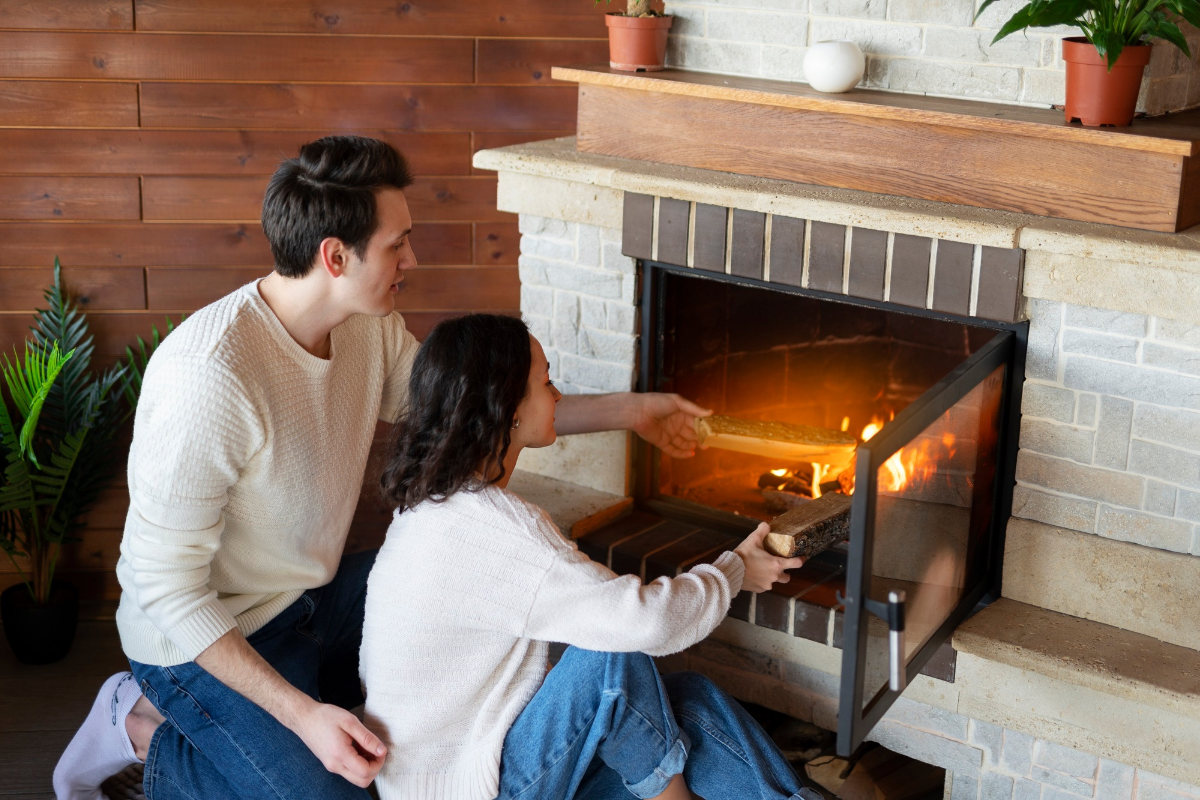Table Of Contents
Choosing the right heating system for your new home is no small feat. With so many options available, it’s essential to consider factors like energy efficiency, installation costs, and your local climate.
A well-chosen heating system keeps your home cosy and helps you save on your property’s energy bills in the long run. Let’s dive into the best ways to heat your new home, examining various options and their benefits to help you make an informed decision.
Assessing your home’s heating needs

Home size and layout
Your property’s total size and layout can significantly impact the kind of heating system you need. Larger homes may benefit from central heating systems, which can distribute heat evenly across multiple rooms.
In contrast, smaller spaces might find radiant floor heating or heat pumps more efficient and easier to manage. Consider open-plan layouts versus compartmentalised spaces, as this affects how heat circulates and whether certain areas might need additional heating support.
Local climate
Your region’s climate plays a significant role in determining the best heating system. Areas with harsh winters, like those that experience prolonged cold spells, might require more robust systems like central heating or ground-source heat pumps.
On the other hand, milder climates might benefit from more straightforward solutions, such as air-source heat pumps or radiant floor heating, which can provide consistent warmth without the need for heavy-duty equipment.
Insulation quality
Proper insulation is critical to maintaining heat within your home. Before deciding on a heating system, ensure your property is well-insulated to prevent heat loss and improve efficiency.
This includes checking your walls, attic, and floors for adequate insulation and ensuring windows and doors are properly sealed. High-quality insulation can lower the workload on your property’s heating system, resulting in lower energy consumption and costs.
Existing infrastructure
Suppose your home already has specific heating infrastructure, such as ductwork for a central heating system. In that case, it might be cost-effective to upgrade or extend it rather than installing a completely new system. Assess the condition of existing components to determine if they can be reused or if they need replacement.
Long-term costs
When choosing a heating system, consider the long-term costs, including maintenance and energy consumption. Some systems might be cheaper to install but more expensive to run, while others might have higher upfront costs but lower operational expenses.
Central heating systems

Overview of central heating
Central heating systems are popular for their ability to distribute heat evenly throughout the home. They typically use a furnace or boiler to heat water or air, which is then circulated through ducts or radiators. This system effectively maintains a consistent temperature across various rooms, making it ideal for larger homes or those with multiple stories.
Gas, electric, and oil options
- Gas: Efficient and cost-effective, but requires a gas supply. Natural gas is typically much cheaper than electricity, making it a popular choice for central heating systems.
- Electric: Easier to install, especially in homes without gas lines, but can be more expensive to run due to higher electricity costs.
- Oil: Useful in areas without gas lines, though oil prices can fluctuate. Oil furnaces are known for their powerful heat output and are suitable for very cold climates.
Installation and maintenance
Central heating systems can be complex to install and require regular maintenance to ensure they run efficiently. Installation typically involves setting up a furnace or boiler, connecting it to the home’s ductwork or radiators, and configuring the thermostat.
Cost considerations
While the initial cost of a central heating system can be high, it often proves economical in the long run due to its efficiency and even heat distribution. Investing in a high-efficiency furnace or boiler can further reduce operating costs by using less fuel to produce the same amount of heat.
Energy efficiency
Modern central heating systems are explicitly designed to be energy-efficient, with many options available to suit different needs and budgets. High-efficiency models can significantly lower your energy bills and reduce your environmental footprint. Look for systems with a high Annual Fuel Utilisation Efficiency (AFUE) rating, which indicates how efficiently the system converts fuel into heat.
Radiant floor heating

How radiant floor heating works
Radiant floor heating involves installing heating elements beneath the floor. The heat radiates upward, warming the room evenly and providing a comfortable, consistent temperature. This system can be used as the primary heating source or as a supplemental system in areas like bathrooms or basements.
Electric vs. hydronic systems
- Electric: Easier to install, ideal for smaller areas or retrofit projects. Electric radiant heating systems use electrical cables or mats installed under the flooring to produce heat.
- Hydronic: Uses heated water, which is more efficient for larger spaces but requires a boiler. Hydronic systems circulate warm water through tubing embedded in the floor, which is more efficient for heating large areas or entire homes.
Installation process
Radiant floor heating is adaptable and can be installed in new builds or during renovations. The process involves laying heating elements under the floor, which can be time-consuming but results in a highly efficient heating system. Professionals should do the installation to ensure optimal performance and safety.
Comfort and efficiency
This type of heating provides a comfortable, even heat that eliminates cold spots. It’s also highly efficient since it heats the room directly rather than warming the air. The even distribution of heat from the floor up ensures that the entire room stays warm, making it a particularly comfortable option.
Cost analysis
While the installation cost can be high, radiant floor heating, especially hydronic systems, is cost-effective to run. The efficiency and comfort it provides can outweigh the initial investment. Over time, the reduced energy consumption can lead to significant savings on heating bills.
Heat pumps

What are heat pumps?
Heat pumps transfer heat directly from one place to another, using electricity to move heat from the outside air or ground into your home. They can also be used for cooling in the summer, making them versatile for year-round comfort. Heat pumps are particularly effective in moderate climates but can also be used in colder areas with supplemental heating.
Air-source vs. ground-source
- Air-source: Cheaper and easier to install, suitable for milder climates. These air-source systems extract heat from the outside air and transfer it indoors. They are effective down to temperatures around -15°C (5°F), after which their efficiency drops.
- Ground-source: More efficient and effective in extreme temperatures but costlier to install. Ground-source heat pumps, also commonly known as geothermal heat pumps, extract heat directly from the ground, which remains at a relatively consistent temperature year-round.
Dual heating and cooling
One of the significant perks of heat pumps is their ability to provide dual HVAC options, making them versatile for year-round comfort. In the summer, the process is reversed, and heat is extracted from the inside air and released outside, cooling your home.
Installation requirements
Installing a heat pump requires professional expertise. Air-source heat pumps are easier to install as they involve an outdoor unit and an indoor unit connected by refrigerant lines. Ground-source heat pumps, in particular, involve significant groundwork, including digging trenches or drilling boreholes for the underground pipes.
Energy efficiency
Heat pumps are highly energy-efficient, often providing more heating and cooling output than the electricity they consume, making them a sustainable choice. They can achieve efficiencies of 300% or more, meaning they produce three times as much energy as they use. This high energy efficiency can lead to substantial savings on energy bills.
Alternative heating options

Wood stoves and pellet stoves
Wood and pellet stoves are excellent for those who prefer a traditional heating method. They can be highly efficient and provide a cosy ambience. Modern stoves are designed to burn wood or pellets cleanly, reducing emissions and maximising heat output.
Solar heating systems
Solar PV heating systems use the sun’s energy to heat your home. While the initial system setup can be expensive, the ongoing energy costs are minimal. These systems typically involve solar collectors that capture and convert sunlight into heat. This heat is then transferred throughout the property.
Suitability for different homes
These alternatives are suitable for various home types and locations, depending on availability and personal preferences. For example, wood stoves are ideal for rural areas with access to firewood, while solar heating systems are best for sunny climates with plenty of sunlight.
Installation and maintenance
Installation can vary in complexity. Wood stoves require a chimney or flue, while solar systems need roof space for the solar collectors. Regular and professional maintenance ensures these systems run efficiently and safely. For instance, chimneys should be cleaned annually, and solar collectors should be debris-free.
Cost and efficiency comparison
While alternatives like wood stoves and solar systems can be cost-effective in the long run, their efficiency can vary based on installation quality and usage. Wood stoves provide intense heat but require manual fueling, while solar systems offer free energy once installed but depend on weather conditions.
Smart thermostats and heating controls

Benefits of smart thermostats
Smart programmable thermostats allow you to control your heating system remotely, optimising energy use and saving on bills. They can learn your unique schedule and adjust the temperature accordingly, ensuring comfort when you’re home and energy savings when you’re not.
Integration with various heating systems
These devices can integrate with most modern heating systems, enhancing their efficiency and ease of use. Whether you have central heating, radiant floor heating, or a heat pump, smart thermostats can help manage your system more effectively.
Energy savings and efficiency
Smart thermostats can significantly lower energy waste by learning your unique schedule and adjusting the temperature accordingly. Features like geofencing can even adjust the temperature based on your location, ensuring your home is comfortable when you arrive and saving energy while you’re away.
Installation and ease of use
Installation is usually straightforward, and smart thermostats are user-friendly, often with intuitive apps for control. Many come with step-by-step guides, and some companies even offer professional installation services.
Popular models and features
Popular models like the Nest and Ecobee offer advanced features such as learning capabilities, remote sensors, and compatibility with home automation systems. These features allow you to customise your heating preferences and monitor energy usage from your smartphone.
Energy-efficient practices

Importance of proper insulation
Proper insulation helps maintain heat within your home, lowering the workload on your heating system and saving energy. Insulating walls, attics, and floors and using double-glazed windows can significantly improve your home’s energy efficiency.
Sealing windows and doors
Sealing gaps around windows and doors prevents drafts, ensuring your heating system works efficiently. Weatherstripping and caulking are simple and practical ways to keep warm air in and cold air out.
Regular maintenance of heating systems
Regular and professional maintenance keeps your heating system running smoothly, extending its lifespan and maintaining efficiency. Annual check-ups can prevent breakdowns and ensure your system operates at peak performance.
Using programmable thermostats
Programmable smart thermostats allow you to set heating schedules, optimise energy use based on your daily routine and set lower temperatures when asleep or away. This can yield substantial property energy savings without sacrificing comfort.
Energy-efficient home design
Designing your home with energy efficiency in mind, such as using energy-efficient windows and building materials, can significantly reduce heating costs. Incorporating passive solar design, which maximises natural heat from the sun, can further enhance efficiency.
Conclusion
Choosing the best way to heat your new home requires careful consideration of copious factors, from home size and local climate to installation costs and energy efficiency. Incorporating smart thermostats and maintaining energy-efficient practices can further enhance your heating system’s performance.
Consulting with heating experts is crucial for personalised advice and professional installation. They can help you navigate the options and find the ideal solution tailored to your home’s unique needs. Investing in the right heating system ensures a comfortable indoor living environment and contributes to long-term energy savings and sustainability.



